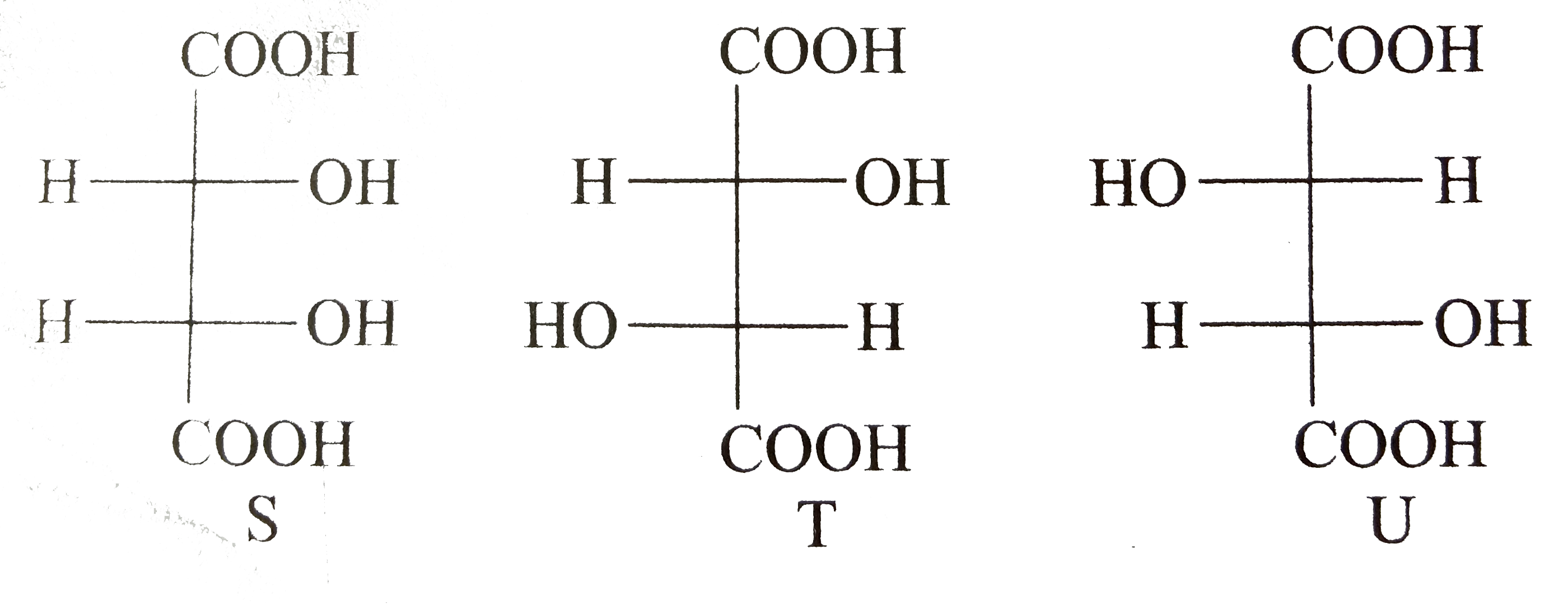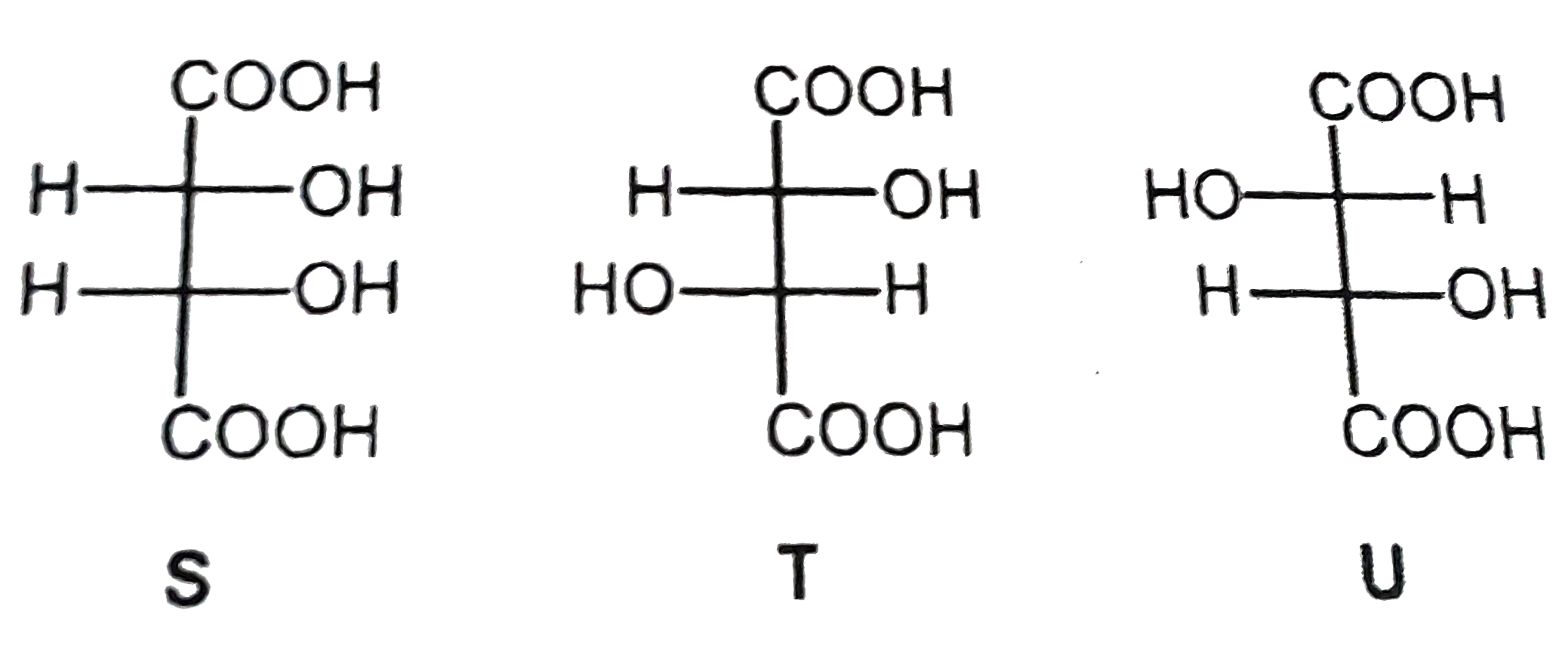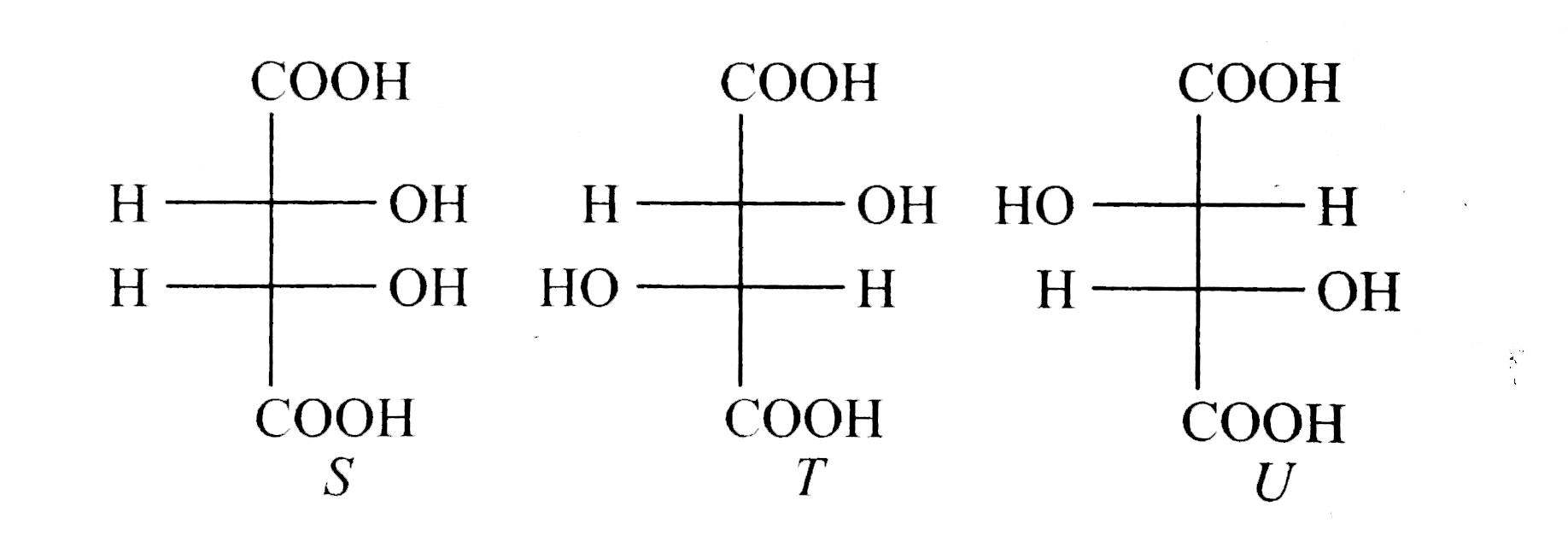P and Q are isomers of dicarboxylic acid C4H4O4. Bothdecolorize Br2/H2O. On heating, P forms the cyclic anhydride. Upon treatment with dilute alkaline KMnO4,P as well as Q could produce one or more than one forms S,T and U.
 Compounds formed from P and Q are, respectively
Compounds formed from P and Q are, respectively
Optically active S and optically active pair (T, U)
Optically inactive S and optically inactive pair (T, U)
Optically active pair (T, U) and optically active S
Optically inactive pair (T, U) and optically inactive S
The correct Answer is:B
Step by step video, text & image solution for P and Q are isomers of dicarboxylic acid C_(4)H_(4)O_(4). Bothdecolorize Br_(2)//H_(2)O. On heating, P forms the cyclic anhydride. Upon treatment with dilute alkaline KMnO_(4),P as well as Q could produce one or more than one forms S,T and U. Compounds formed from P and Q are, respectively by Chemistry experts to help you in doubts & scoring excellent marks in Class 12 exams.
Updated on:21/07/2023Topper's Solved these Questions
- AROMATIC COMPOUNDSBook:RESONANCEChapter:AROMATIC COMPOUNDSExercise:Part - II JEE MAIN
Explore 20 Videos
- AROMATIC COMPOUNDSBook:RESONANCEChapter:AROMATIC COMPOUNDSExercise:JEE MAIN (Online Problem)
Explore 16 Videos
- AROMATIC COMPOUNDSBook:RESONANCEChapter:AROMATIC COMPOUNDSExercise:Part - IV Comprehension
Explore 14 Videos
- ALKYL HALIDE, ALCOHOL, PHENOL, ETHERBook:RESONANCEChapter:ALKYL HALIDE, ALCOHOL, PHENOL, ETHERExercise:ORGANIC CHEMISTRY(Alkyl Halide, Alcohol,Phenol,Ether)
Explore 56 Videos
- BASIC CONCEPTSBook:RESONANCEChapter:BASIC CONCEPTSExercise:ORGANIC CHEMISTRY(BASIC CONCEPTS)
Explore 27 Videos
Similar Questions
A carboxylic acide C2H4O2 reacts with an alcohol in the presence of H2SO4 to form a compound 'X'. The alcohol on oxidation with alkaline KMnO4 following by acidification gives the same caboxylic acid, C2H4O2. Write the name and structure of
Carboxylic acid.
View SolutionA carboxylic acide C2H4O2 reacts with an alcohol in the presence of H2SO4 to form a compound 'X'. The alcohol on oxidation with alkaline KMnO4 following by acidification gives the same caboxylic acid, C2H4O2. Write the name and structure of
Alcohol.
View Solution
Knowledge Check
P and Q are isomers of dicarboxylic acid C4H4O4. Both decolorize Br2/H2O. On heating, P forms the cyclic anydride.
Upon treatment with dilute alkaline KMnO4, p as well as Q could produce one or more than one from the S,T and U

Compounds formed from P and Q are, respectively:AOptically active S and optically active pair (T,U)Boptically inactive S and optically inactive pair (T,U)COptically active pair (T,U) and optically active SDOptically inactive pair (T,U) and optically inactive SP and Q are isomers of dicarboxyhc acid C4H4O4 .Both decolourize Br2/H2O On heating, P forms the cyclic anhydride.
Upon treatment with dilute alkaline KMnO4, P ass well as Q could produce one or more than one from S. T and U.

Compounds formed form P and Q are, respectively.AOptically active s and optically active pair (T,U)BOptically active S and optically inactive pair (T,U)COptcally actve pair (T. U) and optically active SDOptically inactive pair (T. U) and optically inactive SP and Q are isomer of dicraboxylic acid C4H4O4 Both decolourixe Br2/H2O. On heating , P forms the cyclic anhydride. Upon treatment with duilute alkaline KMnO4. P as well a Q could produce one or more than one from S,T and U.

Compounds formed P and Q are, respectivelyAOptically active S and optically active pair (T.U)BOptically inacthive S and optically inactive pair (T.U)COpticaly active pair (Y.U) and optically active SDOptically inactive pair (T.U) and optically inactives S
A carboxylic acide C2H4O2 reacts with an alcohol in the presence of H2SO4 to form a compound 'X'. The alcohol on oxidation with alkaline KMnO4 following by acidification gives the same caboxylic acid, C2H4O2. Write the name and structure of
The compound 'X'.
View SolutionP and Q are isomers of dicarboxylic acid C4H4O4. Both decolorize Br2/H2O. On heating, P forms the cyclic anydride.
Upon treatment with dilute alkaline KMnO4, p as well as Q could produce one or more than one from the S,T and U

In the following reaction, sequences V and W are respectively.

View SolutionP and Q are isomer of dicraboxylic acid C4H4O4 Both decolourixe Br2/H2O. On heating , P forms the cyclic anhydride. Upon treatment with duilute alkaline KMnO4. P as well a Q could produce one or more than one from S,T and U.

In the following reaction sequences V and W are respectively
QH2/Ni−−−→ΔV

View Solution[P] on treatment with H2CrO4 in acetone produced [Q]. [Q] compound upon heating give rise to Acetophenone. The compound [P] is:
View SolutionA substance (P) releases a gas (Q) on reaction with H2O. (Q) decolourises Br2 water. (P) may be
View Solution

